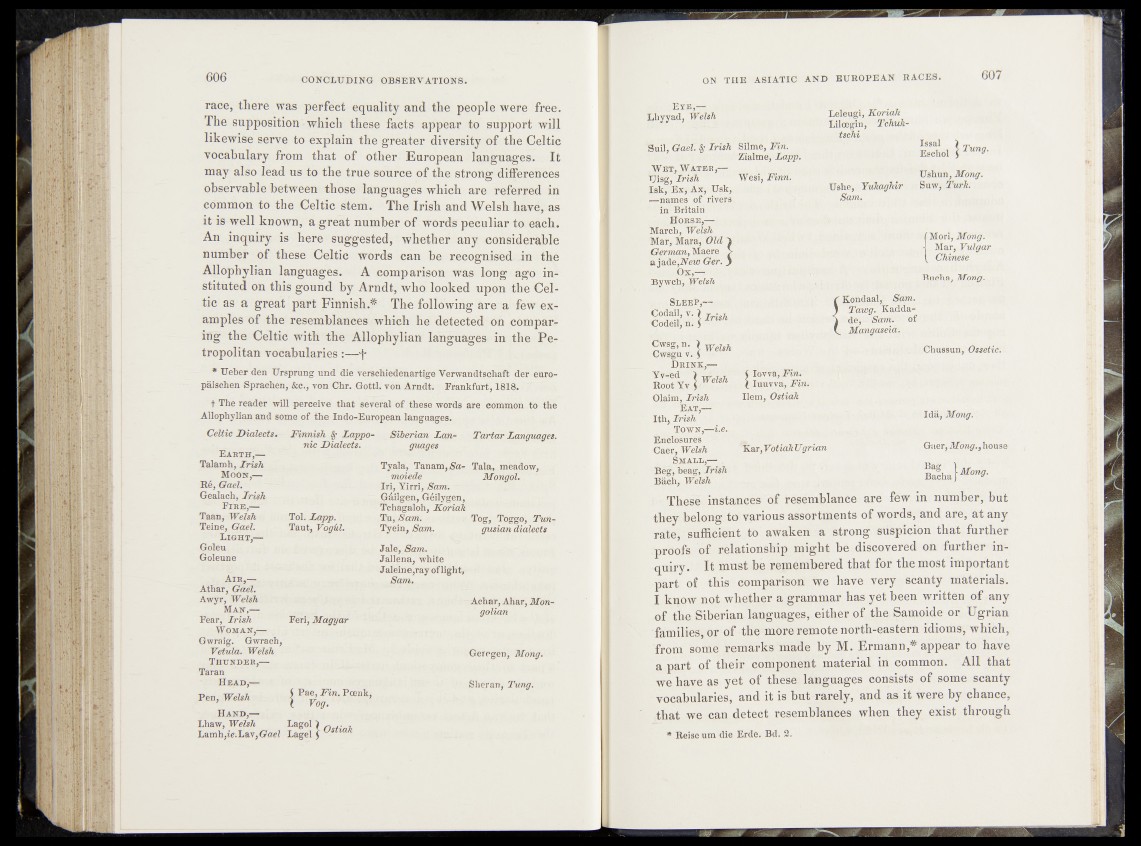
race, there was perfect equality and the people were free«
The supposition - which these facts' appear to support will
likewise serve to explain the greater diversity of the. «Celtic
vocabulary from that of other European languages. It
may also lead us to the true source of the strong differences
observable between those languages which are referred in
common to the Celtic stem. The Irish and Welsh havé, as
it is well known, a great number of words peculiar to each.
An inquiry is here suggested, whether any considerable
number of these Celtic words can be recognised .in thp
Allophylian languages. A comparison was long ago instituted
on this gound by Arndt, who looked upon the Celtic
as a great part Finnish.* The following are a few examples
of the resemblances which he detected oh compare
ifig the Celtic with the Allophylian languages in .the Pe-
tropolitan vocabularies :—f
* Ueber den Ursprung tmd die verschiedenartige Verwandtschaft der * europäischen
Sprachen, See., von Chr..GottL'vou Arndt. Frankfurt, 1 8 1 4 -7
t The reader will perceive that several of these words are common .to the
Allophylian and some of the Indo-European languages.
Finnish §■ Lappo-
nie Dialects.
Tol. Lapp.
Taut, Vogül.
Celtic Dialects.
Earth,—
Talamh, Ir ish
Moon,—
Hê,Gael.
Gealach, Ir ish—
Fire,—
Taan , Welsh
Tein e ,G a e l:
Light,—
Goleu
Goleune
Air ,—
Athar, Gael.
Awyr, Welsh
Man,—
Fear, Irish
Woman,—
Gwraig. Gwrach,
Vetula. W e lsh
Thunder,—
TaranH
ead,—
Pen, Welsh
Hand,—
Lhaw, Welsh
Lamhjie;Lav, Gael Lagel $
Siberian Languages
T a rta r Languages.
Tyala, Tanam,iSa- Tala, meadow,
-moiecte Mongol.
Iri, Yirri, Sam. -—
Gâilgep, Géilygen,
Tchagäloh, Koriak TaySam,
Tyein, Sam.
Jale, Sam.
Jallena, white
Jaleine,ray of light,
Sam.
Tog, Toggo, Tun-
gusian dialects
Feri, Magyar
f Pae, Fin. Poenk,
l Vog.
^ a?°! l O stial
- Achar, Ahar, Mon-
1 goUcm
Geregen, Möng.
Sheran, Tung.
ErR',-7?.
Ipijyyad, Welsh^
'Suit, Gaeh §• I m r S f e , Fin. '
'; » Zïaltne, Lapp.
W ET,W ATE R ,—
y l i g ; I r i s h * W h i , F 0 f?'
Isk, Exj’Axy'Usk,
—names jof rivers,
* tvfn--Britairi
Horse,—
March,, Wels%
Mar, Mara, Old I
ß e rm an , Maere >
a jade,2Vetó Ger. J
Bywch, Welsh ^
Leleugi, Koriak ~
Iailoegin/- Tcfvuk-
tschi
Issal
Eschol Tung.
Ushun, Mong.
SÜshe^r.FtEÄag'^fn r Suw, Turk.
Sam.
( Mori, M&dgW-
■i Mar, Yniggr
V Chinese,
Bucha, Mong. ,
S LEE i? —jj,,
■Codeil, nv.‘ ]$ Irish
Cwsg, n. ) Wehh
Cwsgu v. 5 -
Root Y,v S'.h >
Olaim, Irish
Ith, Irish-. -
Town,—-i.e.
Enclb&uret'iv“
Caer, Welsh
Small,— ,
Beg, bekg, Irish
Bach, Welsh
KondaaLjj Sçqn.
^Wawg. .kadda-
^èÿJ^SarM^ R of
M a n g m e io t ;, t,
Chussun, Ossetic.
C Iowa, Fin.
i lunvyit,-Finj, ;
Hem, Ostiak
Mong.
Kar, VotiakUgrian Guer, Mong., house
Bag )
Bacha [ Mong.
These instances of resemblance are few in number^ but
they belong to various assortments of words, and are, at any
rate, sufficient to awaken a strong suspicion that further
proofs of relationship might he discovered on further inquiry.
It must he remembered that-«for the mostimportant
part of this comparison we have very scanty materials.
I know not whether a grammar has.yet been 'written of any
of the Siberian languages, either of the Samoide or. Ugrian
families, or of the more remote-north-eastern idioms, which,
from some remarks made by M. Ermann,* appear to have
a part of their component material in common. All that
we have as yet of these languages consists of some scanty
vocabularies, aud it is hut rarely, and as it Were by'chance,
that we can detect resemblances when thqv exist through
* Reise um die Erde. Bd. 2.